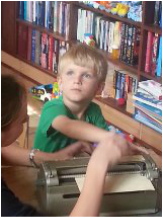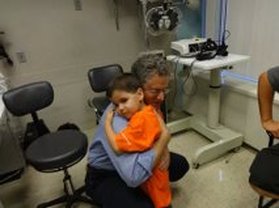 Gabe using a Braille machine
Gabe using a Braille machine To date, there are 19 known genes that cause LCA. When Gabriel was first diagnosed with the disease in 2011, our gene mutation was still unknown. By the time we attended our first conference in 2012, the discovery of our disease-causing gene , NMNAT1, was being published in the scientific journals. Two years later, Gabe's doctor, Dr. Pierce, and his lab are preparing to start a NMNAT1 gene therapy trial on mice. To those of us waiting for a cure, the process seems slow, but in reality, this research has been moving forward at a fast pace in scientific terms.
The efficacy of gene therapy for treatment of LCA was proved with clinical trials aiming to improve vision in those carrying the RPE65 gene mutation. Although the genetic cause of the disease is different, and the presentation may vary, the end result is the same, retinal degeneration and blindness. The RPE65 gene was discovered to cause LCA in 1997, and the first human gene therapy trials were performed in 2007/2008. The results of these trials are what give us tremendous hope for a cure of all forms of LCA. The children in the trial, especially, had amazing results. Some went from being legally blind to reading print books, playing baseball, riding a bike, and of course being able to get around without a cane. The lead researcher, Dr. Jean Bennett, gave an update on some of the trial participants this past weekend. The children are now teenagers. One was attending a summer camp independently, another has been scuba diving, and one also just received his driver's license. A driver's license? When I first contemplated possible treatments for Gabriel, I would have never imagined that the vision restored would allow for driving a car. So how exactly does gene therapy work?
In layman's terms, a viral vector containing the corrected copy of the mutated gene is added to the retina via a tiny needle. The corrected gene then allows the retina to function properly. LCA caused by Gabriel's gene mutation (NMNAT1), results in an under-production of an enzyme, which in turn effects protein production. Theoretically, once the corrected gene is introduced into the retina, a biochemical change occurs allowing, in Gabriel's case, the proper function of this specific enzyme. The photoreceptors, the light-sensing cells of the eye, are directly effected in the LCA disease process. Not only do they not function properly, but over time they begin to deteriorate. Gene therapy only benefits those patients that still have viable photoreceptors left, so time is a factor. What does this mean for Gabe specifically????
I have been thinking about this question A LOT! When Gabriel had his eyes examined at the conference, the doctor explained how treatment could possibly help Gabe in the near future. The NMNAT1 mutation causes severe blindness from birth, but the disease process with this gene seems to move slowly from then on. At least that is what we think. The doctor observed large portions of healthy retinal tissue in Gabriel's eyes, and the lesions on his maculas are still small. This means that he still has viable photoreceptors that could give him possible peripheral vision if he is treated with gene therapy. The fact that the lesion is concentrated in one spot is also good.
We had the privilege of touring Dr. Pierce's lab, where the research is being done on Gabriel's gene. Meeting the researchers in person was incredible. We could sense that their work goes beyond scientific curiosity. These researchers and doctors truly care about the people whose blood samples are housed in their labs! This past year, they have completed the first step in getting to a human trial, the creation of a mouse model. Yes, there is a little mutant mouse, maybe named Gabriel, who was created to mimic the NMNAT1 LCA disease process! Once the lab has enough mice for the study, the actual gene therapy experiment will begin. We were told that one of the mice is pregnant! Yay! If everything goes well, we could be in a phase 1 human trial between 1.5 and 3 years from now.
Since Gabriel's maculas have lesions on them, the therapy may only provide some peripheral vision, but this would improve Gabe's quality of life tremendously. He would go from having nothing to something, and it can be seen as a stepping stone. Gene therapy isn't the only potential answer in treating retinal diseases. There is a lot of research being done with stem cell therapies, especially for the eyes. Bert and I have been following the studies being done on pluripotent stem cells. Researchers are now able to take a skin or blood sample from a patient, revert the cells back to a pluripotent (embryonic-like) state, and coax them to become retinal cells. The idea is to create a patch of a sort, rich in photoreceptor cells, to replace a deteriorated retina. This kind of treatment could eradicate many forms of blindness, as the genetic cause would be irrelevant.
 Gavin Stevens with Dr. Pierce
Gavin Stevens with Dr. Pierce Attending the LCA conference is an educational experience, but connecting with other families and blind adults is just as important. The challenges of raising a blind child are becoming more real as Gabriel gets older. It made a tremendous impact on me to see blind adults leading independent lives, but more importantly leading happy lives. We flock to these conferences in the hope of learning something new about the ongoing research being done on LCA, but the individuals we meet at these events have become part of our extended LCA family and support system. The reality is, that until there is a cure for retinal diseases, we need to raise Gabriel with the skills he needs to be successful as a blind person. This doesn't mean, however, that we stop hoping and fighting for a cure.
 RSS Feed
RSS Feed